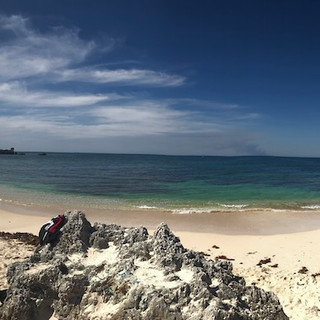Rottnest
- Alejandro Lopez
- Jan 5, 2020
- 2 min read
I made an executive decision to stay an extra day after the Australian Catholic Youth Festival and go visit the quokkas on Rottnest. We took a ferry (1) out to the island that is about 18 kilometers from the mainland. A short 45 minute ride or so. Here we are taking over the lower cabin (2).
What is a quokka? Perhaps you've not heard about these endangered marsupials (of the same family as roos and koalas)? Well, here are some photos (3-5). The small animals are about the size of a squirrel (without the tail). They remind me of mice, but they hop on their hind legs like a kangaroo. And they are extremely tame. (However, due to the fact that they are endangered, you are not allowed to touch them, no matter how much you want to, or risk getting heavily fined!)
You can't help but feel like hugging these cute Disney like critters! The Dutch who first came on the island thought it was infested with rats. The name Rottnest is Dutch and means "Rat's Nest." They had never seen kangaroos before and so assumed these were a species of rats, some with two heads (the babies are carried in pouches like roos, too!)
Once you arrive on the island you are given a free 1.5 hour tour by bus to show you what there is to do. I really thought we could just go off wandering and exploring on our own but was so glad that we took the tour. We learned a lot about the island and its history.
These are colloquially called "broccoli trees" (1). It was a hot, sunny day and so they made some pretty silhouettes. The Indian Ocean is beautifully colored (2). On Rottnest, they have two Osprey nests. One had a nesting pair and I was able to take some close ups of the Mr. amd Mrs. (3-5). The birds mate for life.
The island scenery is quite lovely with the vibrant blue ocean as background. Rock formations jut up and the water is very clear. Sound of waves is ubiquitous.
Quokkas don't swim. Which is why so many have made Rottnest a home. On the mainland of Australia, there is only one other colony of quokkas. The rest have been destroyed when foxes and rabbits were introduced and became invasive.
We only had a couple of hours left after the tour for ourselves. We ate lunch at the "main square" and then headed up to swim at one of the many beaches. Along the way, I found some quokkas in the brush. According to our tour guide, they mostly hang out in the shade during the day and are more active at night. Here is a mom and her joey (what you call baby marsupials) (1).
A light house stood watch over us as we entered the Indian Ocean for a swim (2-4). After awhile, I returned to the main square of shops to write some postcards. As I sat still, some quokkas approached. I couldn't resist a couple of selfies (7-8).
























































Comments